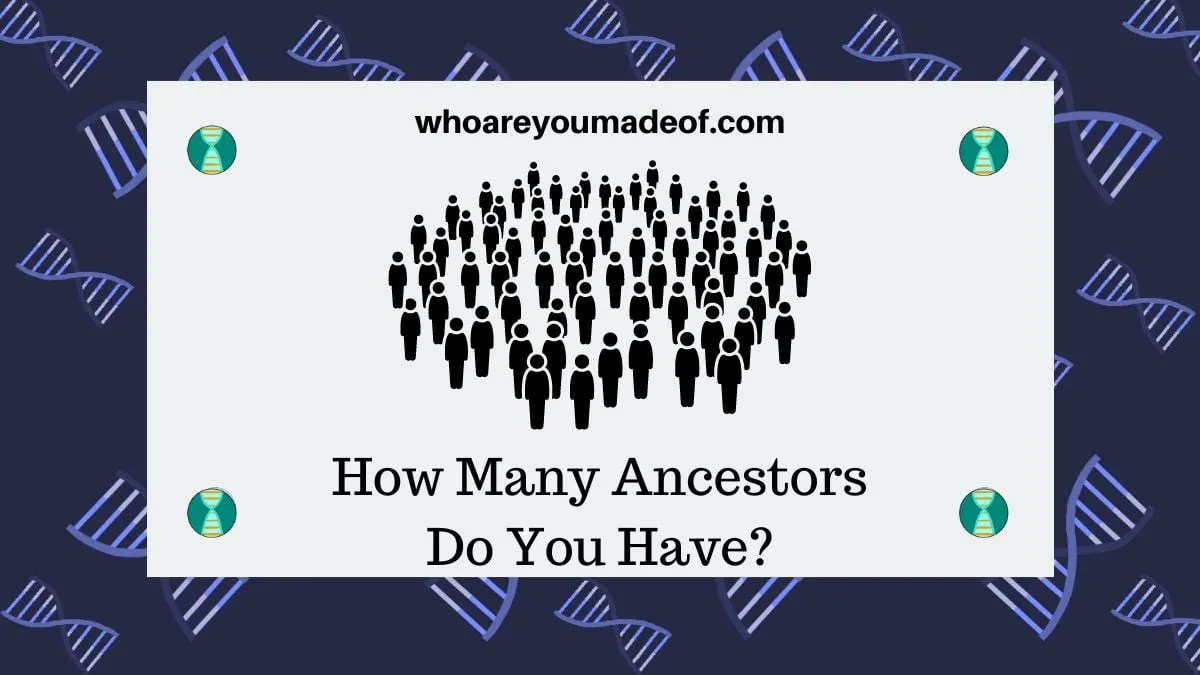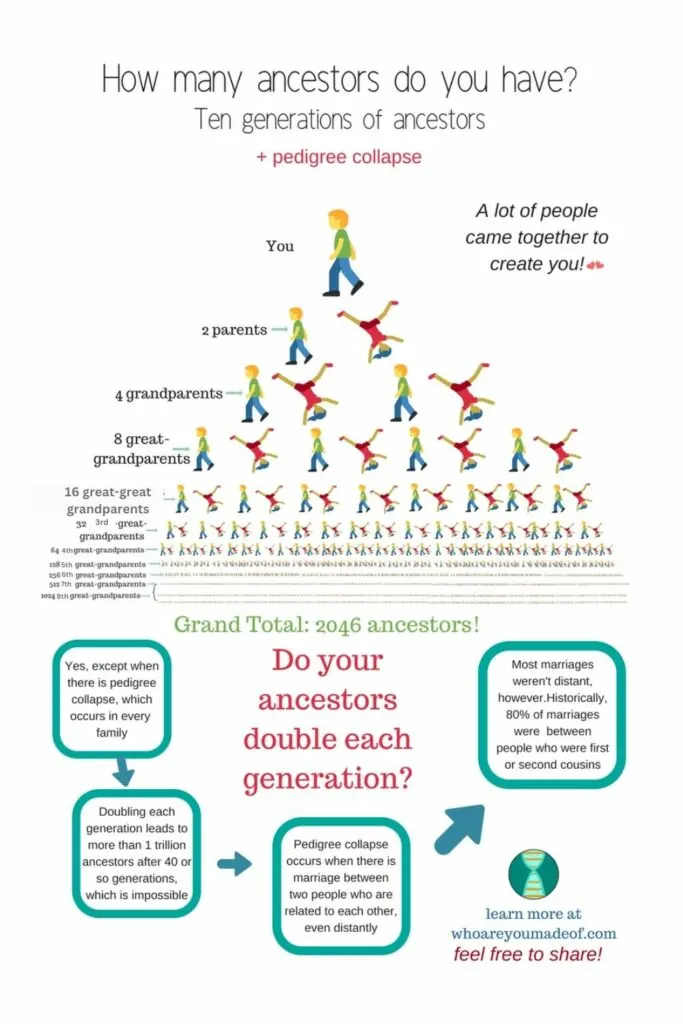Are you wondering how many ancestors you have? In this post, I'll teach you how to figure out how many ancestors you have - with a slight catch.

For those of you looking for a simple answer, we'll start off by looking at the easiest way to estimate the number of ancestors that we have:
Then, if you really want to know how many ancestors you have, we'll learn about how pedigree collapse can affect our actual number of ancestors.
The number of ancestors that we have doubles each generation
Each person, with exceptionally few exceptions, has two biological parents. Each person's parents has two parents, and their grandparents have two parents, and so on and so on.
This means that each generation that you go back into your family tree, the number of ancestors that you have doubles.
Don't want to do the math? No worries, I have done it for you.
Below, you can find the number of ancestors that you have going back 20 generations, or about 500 years (assuming an average of 25 years per generation):
- Parents: 2 (cumulative: 2)
- Grandparents: 4 (cumulative: 6)
- Great-grandparents: 8 (cumulative: 14)
- Great-great grandparents: 16 (cumulative: 30)
- Great-great-great grandparents: 32 (cumulative: 62)
- Great-great-great-great grandparents: 64 (cumulative: 126)
- Great-great-great-great-great grandparents: 128 (cumulative: 254)
- Great-great-great-great-great-great grandparents: 256 (cumulative: 510)
- Great-great-great-great-great-great-great grandparents: 512 (cumulative: 1,022)
- Great-great-great-great-great-great-great-great grandparents: 1,024 (cumulative: 2,046)
- Great-great-great-great-great-great-great-great-great grandparents: 2,048 (cumulative: 4,094)
- Great-great-great-great-great-great-great-great-great-great grandparents: 4,096 (cumulative: 8,190)
- Great-great-great-great-great-great-great-great-great-great-great grandparents: 8,192 (cumulative: 16,382)
- Great-great-great-great-great-great-great-great-great-great-great-great grandparents: 16,384 (cumulative: 32,766)
- Great-great-great-great-great-great-great-great-great-great-great-great-great grandparents: 32,768 (cumulative: 65,534)
- Great-great-great-great-great-great-great-great-great-great-great-great-great-great grandparents: 65,536 (cumulative: 131,070)
- Great-great-great-great-great-great-great-great-great-great-great-great-great-great-great grandparents: 131,072 (cumulative: 262,142)
- Great-great-great-great-great-great-great-great-great-great-great-great-great-great-great-great grandparents: 262,144 (cumulative: 524286)
- Great-great-great-great-great-great-great-great-great-great-great-great-great-great-great-great-great grandparents: 524,288 (cumulative: 1,048,574)
- Great-great-great-great-great-great-great-great-great-great-great-great-great-great-great-great-great-great grandparents: 1,048,576 (cumulative: 2,097,150)
Holy ancestors! That's a lot of people!
Like, a LOT of people. Most of us (all of us?) will never be able to build a family tree going back on every line - on all branches, on both sides of the family - all the way to 20 generations.
There are just too many variables, and besides, not all of our ancestors were born where good records were kept.
How many ancestors do we really have? Realistically?
So, do we really have more than one million 18th great-grandparents? At risk of having one person e-mail me explaining that they are the exception, not one of us has more than one million 18th great-grandparents - and I'll tell you why not.
Basically, it's impossible for the number of ancestors that we have to simply keep doubling every generation.
To demonstrate why it's impossible, let's go further back - just six generations - to 26 generation back, using the doubling method. We'll begin with our 20th generation, and the 1,048,576 18th great grandparents that we would theoretically have at that point:
- 21 generations back: 2,097,152 ancestors
- 22 generations back: 4,194,304 ancestors
- 23 generations back: 8,388,608 ancestors
- 24 generations back: 16,777,216 ancestors
- 25 generations back: 33,554,432 ancestors
- 26 generations back: 67,108,864 ancestors
As you can see, doubling the numbers every generation allows the number of ancestors to get really, really big - and really quickly! This leads us to one reason why this can't possibly be true.
I don't have 33 million ancestors 25 generations ago - it's impossible. My ancestry, at a basic level, goes back to Europe (British Isles, Western Europe, and Eastern Europe), and 26 generations ago (approximately 650 years ago), population estimates for the entire European continent were right about 78 million people.
... you might be able to see where I am going with this by now.
If I go back one more generation - to 27 generations - and still within the 1300s (when about 78 million people lived in Europe), I supposedly have 134,217,728 ancestors. More than 134 million ancestors!
That's almost twice as many people who were even living in the entire continent of Europe at the time. It's very obvious to me that I don't have 134 million ancestors!
To demonstrate how ludicrous it is to keep doubling the number every generation, you should know that at 30 generations back we'd have more than 1 billion ancestors, and at 40 generations, we would have more than 500 billion ancestors.
This is many more ancestors than the number of humans who have ever lived in the history of the world, which is estimated to be at a little over 107 billion people in total.
Pedigree collapse is how we exist
Since we need people to fill in all of those ancestor spots on our hypothetical family tree going back many generations, it might become clear to you that eventually, some of those ancestors in our tree might occupy more than one spot.
What this means is that some of our ancestors are our ancestors on more than one line of our family tree. The technical genealogical term for this is "pedigree collapse".
In most people's family trees, the number of ancestors starts at two (your parents) and doubles going back several generations. This means that the calculations going back a few generations are accurate - you probably do have 64 distinct great-great-great-great grandparents.
(Note: Some of us might find that some of our great-great-great-great grandparents are the same people - more on this - and why - below)
Assuming you could accurately trace your family tree back on all lines, you would eventually start to see the same people pop up on multiple lines of your tree. We know that this happens in most "modern" family trees starting at about ten generations back.
Depending on your unique ancestry, you might see this happen more recently than ten generations, and almost everyone will see it at least once by the time they've researched all their 1,024 8th great-grandparents.
Most people will never be able to know who each and every one of their 1,024 8th great-grandparents are, so it's really tough to prove or disprove this statement.
Why is there pedigree collapse in every family tree?
Back in the day, people lived in small communities. It was beneficial to stay where you were born, generally speaking, since you had an established social network that made survival easier.
When people grow up and choose mates, they generally choose people who they know. This meant that most people that you know were related to you in some way, even it was distant and you didn't even know for sure that you were related.
It was also more socially acceptable to marry people who were related to you, which is demonstrated by the fact that was many as 80% of historical marriages were between people who were were second cousins or closer.
This happened in my own family tree, and not even ten generations ago. Two of my 64 great-great-great-great grandparents (six generations ago) were first cousins.
They shared grandparents, which means that the number of ancestors that I have going back eight generations is two less than the 256 6th great-grandparents that many people have, and I can't simply double that number to get back one generation further, since many of the ancestors are the same.
Conceivably, I will find this more and more as I go further back in my tree, and eventually, the number of ancestors that I have will start to shrink as more and more of them become the same.
And I can guarantee that this same situation occurs in your family tree, too, at some point.
So, is there a way to really know how many ancestors you have?
The only way to be sure about the number of ancestors that you have is to actually count them. But since researching all of your ancestors, equally, on every line, can prove difficult, it's fine to use the "doubling" method to estimate your number of ancestors going back about 10 generations to your 8th great-grandparents.
Check out this graphic I made to help you visualize the number ancestors you have going back 10 generations. I didn't put 20 generation on the chart because, well, you'll have to read the rest of the post to find out.
Don't forget to share this graphic on your favorite social media site or group - I appreciate you!

Conclusion
I hope that this post helped you learn about how many ancestors you have, pedigree collapse, and how this effects how many ancestors you have further back. If you have any questions about something that you read in this post, I'd love to hear from you in the discussion below.
Thanks for stopping by today!

Krumple
Wednesday 18th of June 2025
You are 100% wrong about it being impossible to have 2 million ancestors or more. You neglected the idea that they are not all living at the same time, those are called "trickle" additions. So yes we all have millions of ancestors because the population replaces itself each generation. I love it when people who don't understand linear math try to do linear analysis. There aren't 32 million living ancestors on your family tree. At most probably 4 generations are alive at any one point along the tree. The population gets replaced. That's the key point in how the math works.
Mercedes
Sunday 22nd of June 2025
Thanks for your comment. Nowhere in the article do I say that we can't have millions of ancestors. It's true that all of our ancestors are not living at the same time, but that doesn't really have anything to do with this discussion. If you went 26 generations back in your family tree, you need to fill spots for 67,108,864 people ONLY at the 24th great-grandparent level. That's not counting any other ancestors in your family tree (i.e. the "trickle additions"). What my article is claiming, which is something that has been analyzed by actual math people (since I never claimed to be one!), is that it is unlikely that all 67,108,864 million spots at the 24th great-grandparent level are filled in by DIFFERENT people, meaning that you probably don't have exactly 67,108,864 different 24th great-grandparents. Going back 30 generations, you would need ONE BILLION different people to occupy the spots of your 28th great-grandparents, not counting any other ancestors. Many, if not most, of those ancestors going back 30 generations will likely fill multiple spots on a person's family tree. This is called pedigree collapse, which I explain in the article.
Rick Dondo
Sunday 15th of June 2025
This is a wonderfully well-written explanation of my simplistic summarization of the same concept... in the end, we are ALL... cousins!
Thank you for this. Shared. And referenced on my personal family history site.
Mercedes
Sunday 15th of June 2025
Hi Rick, Thank you so much for your kind comment. I am glad you enjoyed the post! Sincerely, Mercedes
Bruce La Voie
Wednesday 27th of November 2024
Thank you for this, I was running out of soace on my paper for tree branches.
Rheanne
Wednesday 24th of April 2024
Wow quite amazing and mind boggling to think about, I came here because I saw an Australian First Nations man who, for an art exhibition in Italy, wrote out his entire family tree going back 2400 generations! Thinking about this I just don’t understand how that’s possible.
j fellows
Sunday 17th of September 2023
Fliping it on its head. each of your 20th genoration forbers will (statisticaly speaking) have had 2 or more surviving children. from each of them down the genorations the same maths aplies: 2, 4, 8. 16.... So each of them is the ancestor of most of the population. wich means that whom ever you sleep with is your cousen thousends of times over.